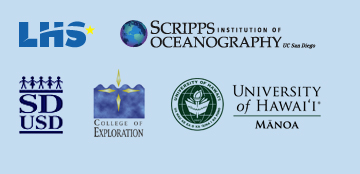 |
|
| SEARCH | FREQUENTLY ASKED QUESTIONS | ||||
|
Frequently Asked Questions
Is the science content rigorous enough to warrant university credit in oceanography? Yes. The course has been offered in science departments in 19 colleges and universities (for 2-4 units), so the content is rigorous. But the focus of the course is on learning theory and pedagogy (pedagogical content knowledge) not oceanography. To give students additional information on topics that they teach in outreach activities, we often use a combination of recommended readings from marine biology and oceanography texts, explanatory handouts and presentations. Our evaluation studies tell us that students learn ocean sciences content during the course, but COS should not be seen as a replacement for a comprehensive oceanography course. Is the course content rigorous enough to meet the requirements of a graduate level course? Yes. COS-K12 and COSIA are taught to both graduate and undergraduate students at most colleges and universities (including Stanford, USC and Rutgers University). However, it is best offered as a “cross-listed course” allowing graduate and undergraduates to learn from each other. At UC Berkeley, the course even fulfills a requirement for graduate students to take a course in "teaching" before they are allowed to become a GSI. How many students have typically been in a class or course section? This varies widely. Some places have had as few as 8, while at UC Berkeley we have had to cut off enrollment at 40. We think 24 or so is a good number, but we have no evidence to support that one number is better than another. If the numbers are too low, it is hard to model some of the discussion-leading and inquiry strategies that we want students to use in their own teaching. However, some universities are successfully offering the course with fewer students as a seminar-style course. With too many students, it can be difficult to find enough outreach placements for the student teaching component. How many outreach visits are needed to ensure students receive enough “teaching” experience? Though the number of visits varies between COS-K12 and COSIA, the goal is to have students spend a total of 6-12 hours “teaching.” If students are doing outreach in K-12 classrooms (for COS-K12), we suggest they visit the class once to observe, then once a week for 1-2 hours/week for six weeks, for a total of 6-12 hours. If the students are doing outreach in a science center or aquarium (for COSIA), we suggest the same number of total hours of teaching, but they could be divided up very differently (e.g., three 4-hour bouts or any other combination that suites the needs of the institutions involved). It is time consuming to set up the placements, so that is why we suggest that a scientist and an educator co-teach the course. Ideally, the educator will already have a relationship with local schools or near-by aquarium/science center. If finding the placements is problematic, we suggest you start off with a small class size. Since students do their teaching in pairs, a class of 12 only needs 6 placements. Is the course content adaptable enough to ensure relevance to a variety of audiences and regions? Yes. The courses are modular enough that you could substitute additional curriculum and content in some or all class sessions, such as increased graduate level content. From our point of view, the specific content of the "exemplars" is not nearly as important as whether or not they exemplify some aspect of pedagogy or pedagogical content knowledge. If an institution wanted to use local examples, we're happy to provide technical assistance, but they would have to provide the examples themselves and any necessary teaching materials. What is expected of the institutions offering the courses? The institution is responsible for approving and listing the course, and providing a scientist and an educator to co-teach the course (it has been taught once by a scientist alone and once or twice by educators with very strong content background). The other major responsibility is developing or purchasing a set of "kits" for students to use in their own outreach teaching. We, however, provide all the course materials: instructor's guide, session power-points, reader, homework assignments, course description, and K-8 curriculum for students to take into classrooms (COS-K12) or activity write-ups for use in informal learning centers (COSIA). What kind of training do you offer to new instructors of the courses? We offer two kinds of in-house hands-on training, in your house or ours! We can come to the instructors or the instructors can come to us. We offer a 2-day workshop annually. It's ideal to participate in the workshop since you not only get the "training," but you also benefit from the interaction with people from all over the country who are planning to teach the course. My institution received a subaward for its participation in COS/COSIA, are there sustainability expectations after the award? Expectations: no. Hopes: yes! We have confidence that the course will be successful and that the college/university will want to sustain it. We are into year four now and we don't believe anyone has dropped out. Additionally, everyone who has taught the course has taught it again the following year. Are there funds available for participating universities? There are some training funds but no implementation funds. We have actually never provided funds for any campus to teach the COS-K12 and COSIA courses. In the past we have been able to pay to bring instructors to Berkeley for a 2-day workshop and provided the course materials for free, but the campuses have always paid for the course to actually be taught. |
|
|||

